The first Bordeaux 2021 en primeur releases have started to trickle through over the past two weeks, with key entries from Batailley, Carruades de Lafite, Duhart-Milon, Pavie, Cheval Blanc, Léoville Las Cases, Angélus, and the Barton family wines.
Kicking things off on Monday 9th May, Batailley 2021 was released at £27.50 per bottle (flat on the 2020 and 2019 release prices), setting a positive pricing tone in a year where reduced quantities had prompted apprehension. Indeed, the estate’s Managing Director, Frédéric Castèja informed Wine Lister that Batailley saw no mildew in 2021, and yields are therefore at a “normal” 50 hl/ha.
Released on Thursday 12th May at £165 per bottle, Carruades de Lafite 2021 similarly presents a discount on the 2020 and 2019 release prices, while entering the market below current prices of all recent back-vintages. The wine has shown to be one of the best price performers post-release in Wine Lister’s latest Bordeaux Study, with the 2020 already witnessing a 39% price increase over the past year. Carruades’ younger cousin, Duhart-Milon 2021 was also released on Thursday at £56 per bottle.
Another encouraging price move countering the early fears of the trade, Pavie 2021 was released on Wednesday 18th May at £232 per bottle – offering a discount of 3%-13% on all physical vintages back to 2015. Cheval Blanc 2021 was released on Thursday 19th May at a slight premium on the past two years’ release prices, though still below average prices of all back-vintages on the market up until 2014. With a quality that matches recent top vintages (2019, 2018, 2016, 2015), while priced at an average 28% below them, the 2021 has already seen successes. Indeed, one top UK merchant reports having sold “even more than last year”.
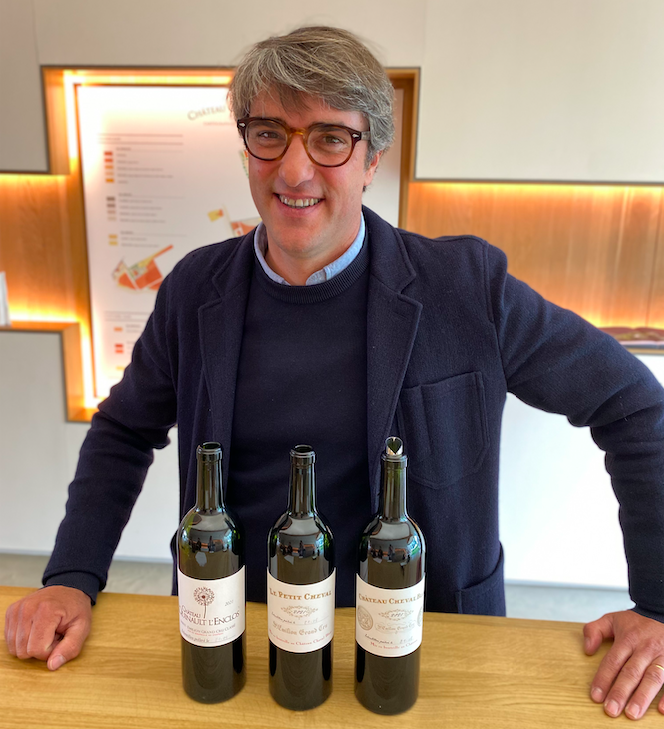
Cheval Blanc’s Technical Director, Pierre–Olivier Clouet, taking the Wine Lister team through the 2021s
A similarly successful entry (in the words of another top UK merchant), Léoville Las Cases 2021 was released on Friday 20th May at £162.50 per bottle – a significant 18% down on the 2020 release price. As well as offering the greatest discount from last year’s opening price seen of key releases thus far in the campaign, the 2021 receives a score of 94-96 from both Vinous’ Antonio Galloni and Neal Martin.
Upping the pace this week (on Monday 23rd May), we saw further releases from Angélus and the Barton family. The 2021 is the first vintage of Léoville Barton and Langoa Barton vinified in the Barton family’s new winery, and the last before the passing of the estates’ legendary owner, Anthony Barton. The vintage also marks 200 years of the family’s ownership of Langoa Barton, which will be commemorated with a special-edition label on the 2021, and the release of a limited-edition, multi-vintage case.
Also released during this period: Carillon d’Angélus, La Lagune, Petit Cheval, Cantemerle, L’Extravagant de Doisy-Daëne, Potensac.
Wine Lister’s real-time, wine-by-wine analysis of this year’s campaign is available in email newsletter form through a Pro+ subscription. For more information on this, please contact us.
Wine Lister’s COO, Chloe Ashton shares her thoughts on this year’s en primeur campaign so far.
The latest Bordeaux en primeur campaign is already underway, with Batailley 2021 opening the stage at the beginning of last week, and Domaines Baron de Rothschild’s Carruades and Duhart-Milon following suit. Cantemerle’s release on Friday 13th rounded out the week, and thus far starting prices have been a relatively pleasant surprise.
What does the trade expect from this year’s campaign?
In Part I of Wine Lister’s annual Bordeaux study, we asked key members of the global fine wine trade about their expectations ahead of the 2021 campaign. Of 47 respondents, half expected prices to be somewhat more expensive, or significantly more expensive than 2020 vintage releases, after rumblings on La Place of strong trading over the past few months.
 Bordeaux study (p.10): Founding members survey – 2021 release price expectations
Bordeaux study (p.10): Founding members survey – 2021 release price expectations
After the first physical en primeur week in Bordeaux since the 2018 vintage (our view of the vintage can be found here), the trade will at least have had the chance to work their way through a vintage so complex that tasting was surely a necessity. With such a heterogenous vintage, pricing strategies should logically also be extremely varied, making the potential successes of 2021 sales difficult to predict. Nonetheless, here’s what we know:
- Wine Lister’s annual Bordeaux study reveals that confidence in Bordeaux us up. Respondents increased ratings on last year for three quarters of the wines included in our study – after so many trade members have been reminded of the joys of tasting in situ, both these elements could contribute to campaign positivity and momentum, with merchants backing those properties they historically believe in, and/or were indeed impressed by during en primeur tastings
- 2021 appears to be a vintage that speaks from the soil, so imparting knowledge of the best terroirs to customers should help to create demand for the best-performing wines in general
- Outside of focusing only on the very best, 2021 may be a vintage for pleasant surprises – the fresher, lower-alcohol, and more classical style of wines certainly garner appeal from traditional palates, so any merchant or collector seeking this style of drinking experience in the near to mid future could do well in seeking out some of the better-value wines hailing from this complicated campaign
Wine Lister’s wine-by-wine analysis of this year’s campaign is available in email newsletter form through a Pro+ subscription. For more information on this, please contact us.
Wine Lister’s Founder and CEO, Ella Lister shares her thoughts on Bordeaux’s 2021 vintage.
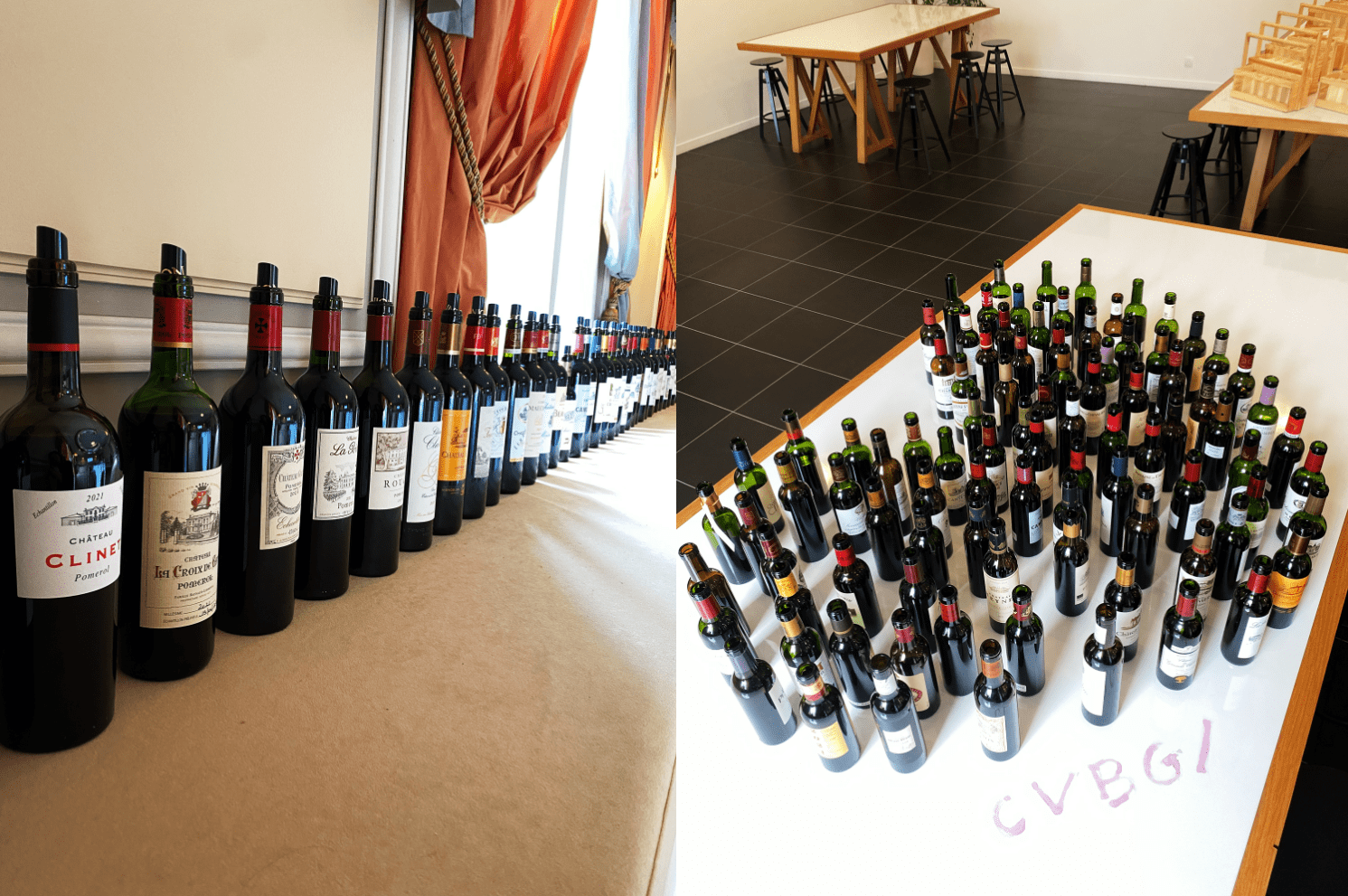 Bordeaux en primeur tastings: UGCB (left) and CVBG (right)
Bordeaux en primeur tastings: UGCB (left) and CVBG (right)
What can we expect from Bordeaux 2021?
The most complicated vintage since 2013, Bordeaux 2021 had everything thrown at it. The vines suffered a barrage of challenges during the growing season, from frost, then mildew, to a lack of the all-important hydric stress during a cool, cloudy summer. “It was a tiring vintage for us, and psychologically difficult” recalls Juliette Couderc, the new technical director at Château L’Evangile.
Bordeaux had been lucky with six relatively clement vintages in row, and en primeur tasters had been spoiled – especially with the trio of 2018, 2019, and 2020. Tasting more than 350 wines from the 2021 vintage in late April, we were reminded of en primeur tastings of old – the art of seeing through the wood, the hard tannins, the searing acidity, and attempting to form an idea of the wine’s future potential. And potential there is, if much less widespread than in the last three years. Buying decisions will need to be made carefully, and the critics’ views will be more important than in recent vintages blessed with high quality across the board.
Vinegrowing and winemaking have come on even in nine years, with know-how and tools at the disposal of producers that they didn’t necessarily have in 2013. Furthermore, 2021 had a saving grace – an unusually long growing season, beginning with early bud break, around the beginning of April, and ending with harvest dates running well into October, thanks to an Indian summer that finally provided some much-needed sunshine, with the sunniest October since 1991. Pierre-Olivier Clouet, technical director of Château Cheval Blanc, referred to a vintage “slow-cooked at a low temperature” following six years of cooking “on a high heat”.
The vintage was more challenging for merlot than for cabernet (franc or sauvignon), as the grape variety is more susceptible to mildew. Being an early ripener, merlot also missed out on the best of the Indian summer, whereas much cabernet benefitted from a warm and sunny early October, where vignerons dared to ignore the pessimistic weather forecasts for the weekend of 3rd and 4th October and hadn’t already rushed to pick before the non-existent rain. “The weather forecast was predicting an apocalypse,” recalls Vincent Millet, managing director of Château Calon-Ségur in Saint-Estèphe, but the cabernet grapes weren’t ready, so he waited, “and in the end there was no rain at all, and then a good stint of sunshine”. Further south in Margaux, Alexis Leven-Mentzelopoulos, co-owner of Château Margaux, echoes, “It was out of the question to pick unripe grapes ”.
At Château Ducru-Beaucaillou in Saint-Julien, owner Bruno Borie says the 2021 vintage is an “ode to cabernet sauvignon, which was much more resistant than merlot at every step.” However, cabernet’s upper hand in 2021 does not neatly translate into a left-bank vintage as might be expected. The right bank has its fair share of hits, and, bizarrely, fewer misses.
The watchword in 2021 is heterogeneous, and quality is undoubtedly very patchy in 2021, ranging from the seriously disappointing to the truly exceptional (though we are not in 100-point territory in this vintage). This makes it a hugely interesting en primeur campaign to taste, to sell, and to buy. It is a year where châteaux had a real opportunity to stand out from the pack, usually thanks to outstanding terroir and the application of significant resources – both financial and human. “It was viticulture seven days a week,” explains Jean-Emmanuel Danjoy, estates manager of the Château Mouton-Rothschild stable, who, like many others, underlined the vital importance of the team’s unstinting dedication. It was necessary to adapt tirelessly in the vineyard and in the winery; to accept that the fruit coming in at the end of the season wasn’t that of the three previous vintages, and be willing to throw out tried and tested recipes to make a different kind of wine, suited to the vintage. “We didn’t go looking for density that simply wasn’t there”, underlines Vincent Decup, technical director at Château Montrose in Saint-Estèphe. Down the road at Cos d’Estournel, Dominique Arangoïts points out “it’s an opportunity for wine lovers to really uncover the terroir, because the wines are stripped right back.”
The biggest challenges were to achieve a full enough body and to avoid vegetal (pyrazine) notes, without over-extracting hard, green tannins or being over-reliant on new wood, which the more delicate fruit couldn’t absorb. Many of the more successful properties used gentler extraction techniques than ever, and added a significant proportion of press wine to fill out the mid-palate. Chaptalisation was widely resorted to for the first time since 2013. The 2021 vintage nonetheless offers refreshingly modest alcohol levels – around 13% rather than the 15% or 15.5% which had become ubiquitous in recent years – potentially a key selling point with consumers.
Generalisations are not easy (or wise) in a vintage of such disparity of quality and style, but with few exceptions, the red wines tend to come in a lighter, fresher vein, recalling the classical clarets of the 1980s and 1990s. “It’s a wine style from the 80s, but with ripe grapes,” muses Aymeric de Gironde, president of Château Troplong-Mondot. The fruit is more red than black, with lots of raspberry and even some rhubarb. The vintage is less opulently floral than the last three, and floral notes are more often on a slightly more vegetal spectrum – iris, violet and lily. The worst wines have hollow mid-palates and searing acidity, and often an overdose of oak. The very best are so pure and soothing that you would never imagine the sweat and tears that went into making them. For Olivier Gautrat, maître de chai at Château L’Eglise Clinet, it was “a difficult and exhausting vintage. We’ve been out of the habit of less explosive flavour in the grapes, so we were really scared, but the more we taste, the more we find real charm in the 2021s. ”
The dry whites are pure and fresh, and the best have a sumptuous complexity. The sweet whites are remarkable, but produced in tiny quantities, if at all. For this reason Christian Seely describes Château Suduiraut 2021 as “tragically beautiful”, with yields of less than 1 hl/ha. What the reds, whites, and sweet wines all share is high acidity, which will likely result in long ageing capacity. We look forward to tasting the wines again in bottle in a couple of years to confirm that!
350+ tasting notes will be published (in French) at Le Figaro Vin next week. In the meantime, watch this space for part II of this blog series, with a focus on the Bordeaux market, to be published next week. To track the impending Bordeaux en primeur releases, click here to discover our en primeur page.
In anticipation of this year’s en primeur releases, Wine Lister has published Part 1 of its annual in-depth Bordeaux Study. In collaboration with the world’s most visited wine website, Wine-Searcher, our market overview examines the region’s price performance and comparative popularity progression. Drawing upon valuable insight from 47 leading trade survey respondents, the study also identifies which properties have benefited from a rise in trade confidence over the past year, and explores recommendations for châteaux and merchants to see a successful 2021 en primeur campaign.
Please see our key findings below:
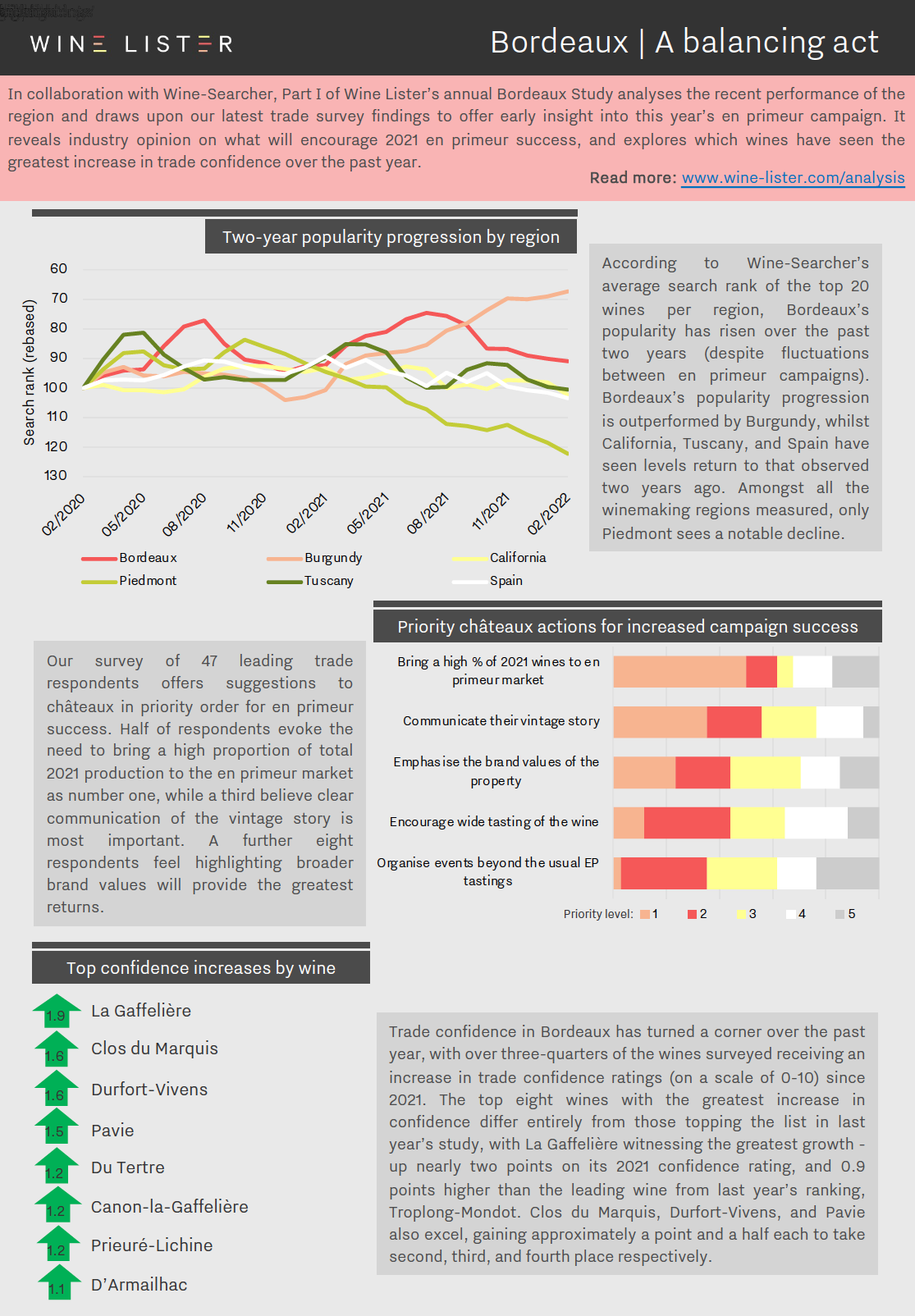
You can download the study digest here: Wine Lister 2022 Bordeaux Study – Digest. The full report can be purchased on our Analysis page, while Pro subscribers can access their free copy here. For further information on the data source, please see the Wine-Searcher website here.
Insight from Burgundy’s regional specialist
Wine Lister’s partner critic and leading Burgundy expert, Jasper Morris MW completed the release of his Burgundy 2020 scores last week. Below we take a closer look at his top ratings per appellation subset.
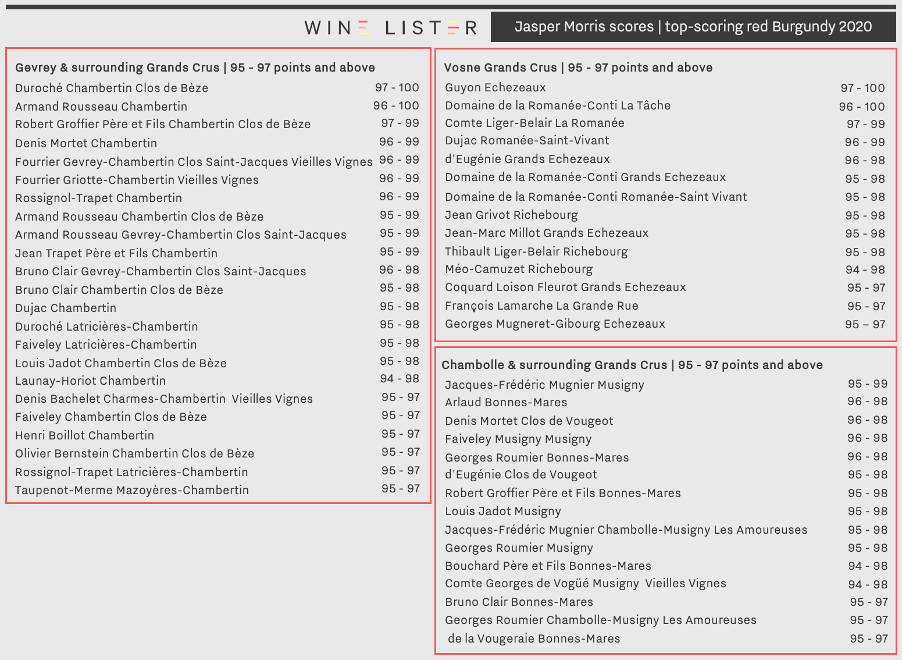
How did Burgundy’s appellations perform in 2020?
Jasper Morris’ Burgundy 2020 report outlines the challenges brought about by such a hot and dry summer, with soaring temperatures throughout August leading to a deficit of juice, particularly in Pinot Noir. The inability of certain rootstock to deal with the hot dry conditions led to the threat of dieback disease (a fungal disease that attacks the trunk, appearing more frequently in stressed vines), with Jasper noting he has “never seen as many vines being ripped out as [he] did in autumn 2020”. Indeed, both factors resulted in relatively low yields for reds, with a number of producers in the Côte de Nuits having “made more wine in the frost-damaged 2021 vintage than they did in 2020.”
Nonetheless, Jasper reported that the hydric stress “concentrated everything, including acidity”, identifying wines with “profound intensity beyond anything [he] saw in 2018 and 2019.” He describes a “universally successful vintage for the white wines”, and a “wider range of styles and successes in the reds”.
Côte de Nuits
With almost all of his top scores given as ranges, much of Jasper’s tasting this year took place whilst wines were still in barrel, as many producers were “tempted to increase the length of élevage for their wines, especially the reds, given the exceptional concentration of the fruit”. This contrasts with the majority of singular scores awarded to the in-bottle samples he rated at the same time last year, and while 2019 did not see any potential 100-point wines, the Côte de Nuits 2020s have five.
The selection includes Duroché’s Chambertin Clos de Bèze and Armand Rousseau’s Chambertin, with the former released as a limited edition cuvée to mark 100 years since the Duroché family planted vines on the site. Also potentially perfect are Guyon’s Echezeaux and Domaine de la Romanée-Conti’s La Tâche, with Jasper suggesting the former “could be THE wine of the vintage.” Completing the line-up is Perrot-Minot’s Richemone Vieilles Vignes, a Premier Cru with a vibrancy that Jasper considers “almost unsurpassed anywhere in the Côte”.
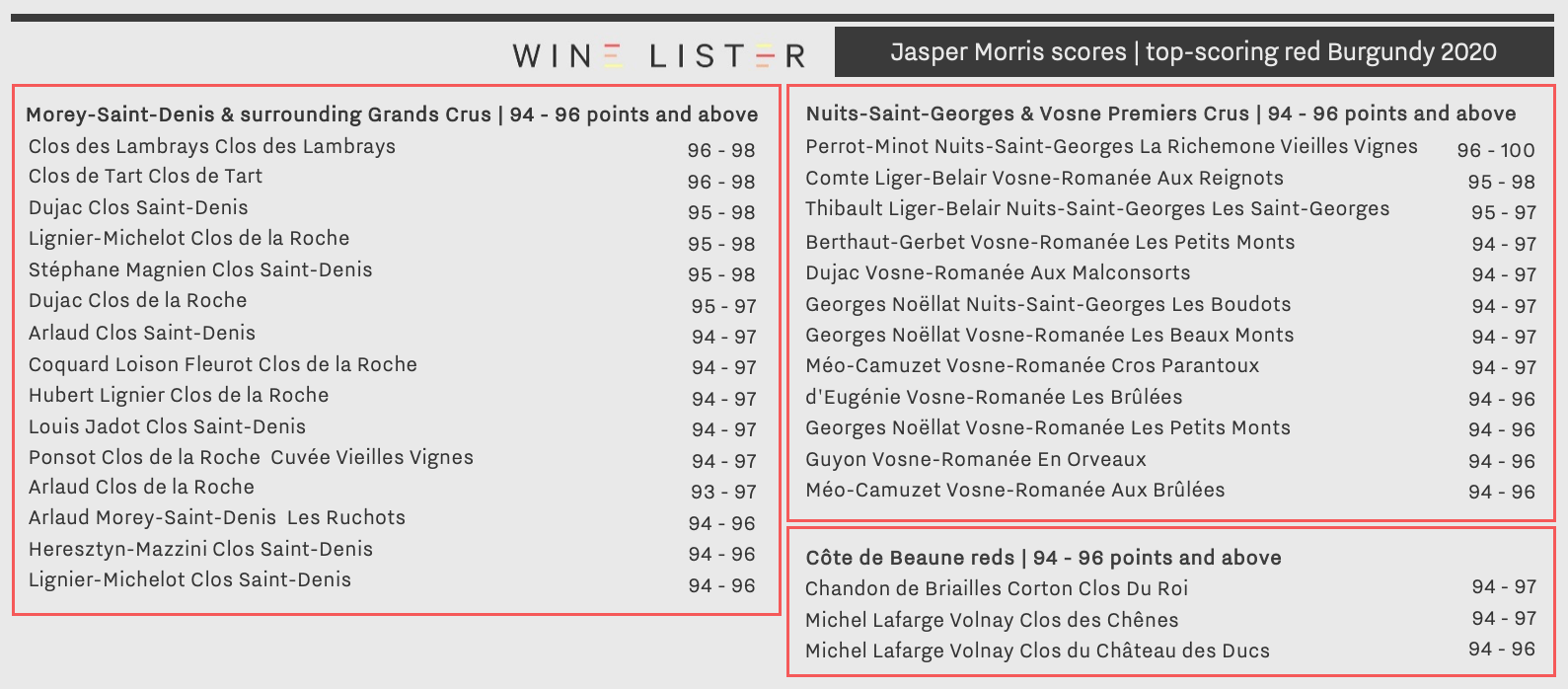
Within Morey-Saint-Denis and its surrounding Grands Crus, Clos de Tart’s namesake cuvée shares the top score for a second year in a row, earning 96 – 98 points, having been complimented for its “spectacular depth”. Clos de Lambrays – nurtured by Clos de Tart’s previous winemaker, Jacques Devauges, since 2019 – matches the rating.
Côte de Beaune – reds
Jasper reports that the most challenging conditions were felt where grapes typically ripen first, including the southern villages of Volnay and Corton. Despite this, several reds including Michel Lafarge’s Volnays Clos des Chênes and Clos du Château des Ducs, and Chandon de Briailles’ Corton Clos du Roi fare well, the latter described as having the “most sensual nose of all”, with notes of “alpine raspberries”.
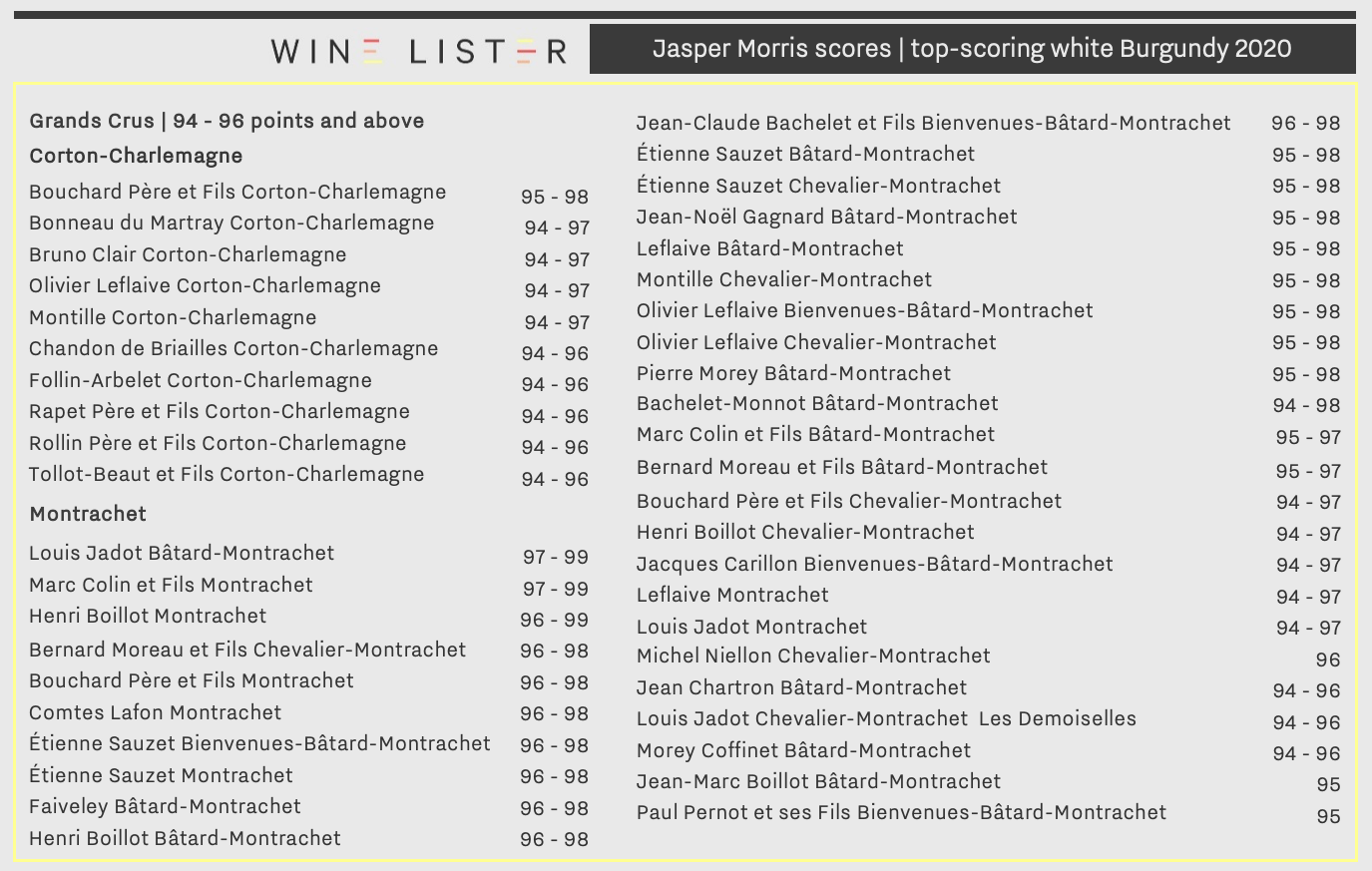
Côte de Beaune – whites
Jasper awards 71 white Burgundy 2020s a score of 94 – 96 and above, compared with last year’s 29 wines scoring 95 and above. He stresses the success of the 2020 vintage across the whites, with Chardonnay grapes retaining more juice than Pinot Noir, and benefitting from a longer ripening time. Montrachet and associated white Grands Crus saw two wines with a potential 99 points – Marc Colin’s Montrachet and Louis Jadot’s Bâtard-Montrachet.
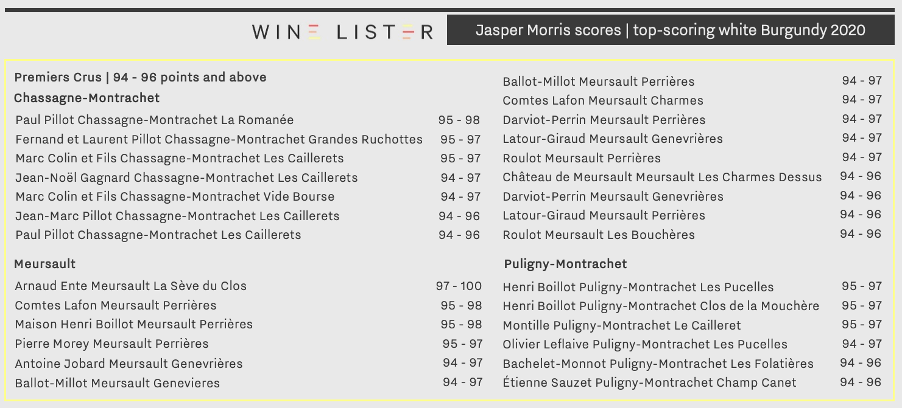
Bouchard Père et Fils’ Corton-Charlemagne achieves a score of 95 – 98, and is praised for expressing “a really impressive wealth of fruit”. Earning the only potential 100-point score for whites in 2020, Arnaud Ente’s Meursault La Sève du Clos was particularly memorable, with Jasper affirming that he has “never seen this consistently great wine as expressive before”.
Explore Jasper Morris’ full Burgundy 2020 report here. For more Burgundy 2020 commentary from our partner critics, recap Neal Martin’s ratings here, and stay tuned for the last lot of scores from Jancis Robinson.com.
The first of Wine Lister’s partner critics to release scores for the latest Burgundy vintage, Neal Martin’s assessment (for Vinous) provides initial insight into some of the top en primeur picks in 2020.
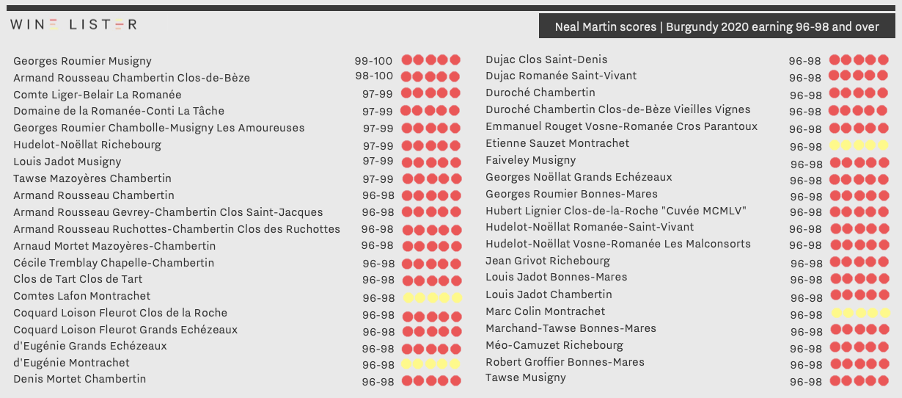
What do we know about Burgundy’s 2020 vintage so far?
2020 will be remembered as a year that saw some of the earliest harvest dates ever recorded in Burgundy, with several of the region’s producers picking as early as 12th August. Though following the pattern of recent vintages marked by warm and dry growing seasons, the threat of drought was partly alleviated by significant rainfall during the winter months through to spring, which ensured water reserves were replenished ahead of the heat. Some Pinot Noir producers nonetheless saw a drop in yields, particularly on sites with poorer soils, and thus restricted water retention ability.
Dry conditions during ripening minimised the threat of disease and mildew, which was valuable for the healthy growth of red and white grapes. Despite the earlier harvest, the grapes saw excellent ripening and phenolic development, while high levels of evaporation concentrated sugars, flavours, and acidity.
The top-scorers
Compared to the 19 wines that Neal Martin awarded 96-98 and above last year, there are an impressive 40 wines within the same parameter for the 2020 vintage. While there were no wines that earned a potential perfect score in 2019, Georges Roumier’s Musigny and Armand Rousseau’s Chambertin Clos-de-Bèze receive 99-100 and 98-100 points respectively in 2020. Neal Martin notes that the top-scoring reds of the vintage all share an excellent acidity, which “lends the 2020s a sense of brightness”.
Also faring notably well, Comte Liger-Belair’s La Romanée, Domaine de la Romanée-Conti’s La Tâche, Georges Roumier’s Chambolle-Musigny Les Amoureuses, Hudelot-Noëllat’s Richebourg, Louis Jadot’s Musigny, and Tawse’s Mazoyères Chambertin earn scores of 97-99.
Whites worth trying
Four whites hailing from Montrachet appear on the list, with offerings from Comtes Lafon, Domaine d’Eugénie, Etienne Sauzet, and Marc Colin each earning a score of 96-98. Neal Martin describes mineral notes across each, having written that this was one of the great attributes of the top whites in the vintage – especially across those grown on more “calcareous soils” akin to that which Montrachet boasts. Following the trend of white burgundy producers using less new oak, Marc Colin uses only old oak barrels for the first time in this vintage, while Comtes Lafon matured Montrachet in one-third new oak instead of 100%.
Discover Neal Martin’s full list of Burgundy 2020 scores here. Watch this space for further Burgundy 2020 score updates from Wine Lister’s partner critics, JancisRobinson.com, and specialist Burgundy critic, Jasper Morris MW.
Tales of the 2016 told by Castiglion del Bosco
One of the highest-scoring vintages in recent decades, 2016 has been described as a milestone for Montalcino and its flagship wine, Brunello. Providing the first taste of 2016 Riserva in the UK, WLPR was honoured to accompany Castiglion del Bosco through an early preview of its monumental Riserva Millecento 2016 release (set for January 2022) at London’s Enoteca Turi, joined by a handful of the city’s leading trade figures and fine wine collectors.
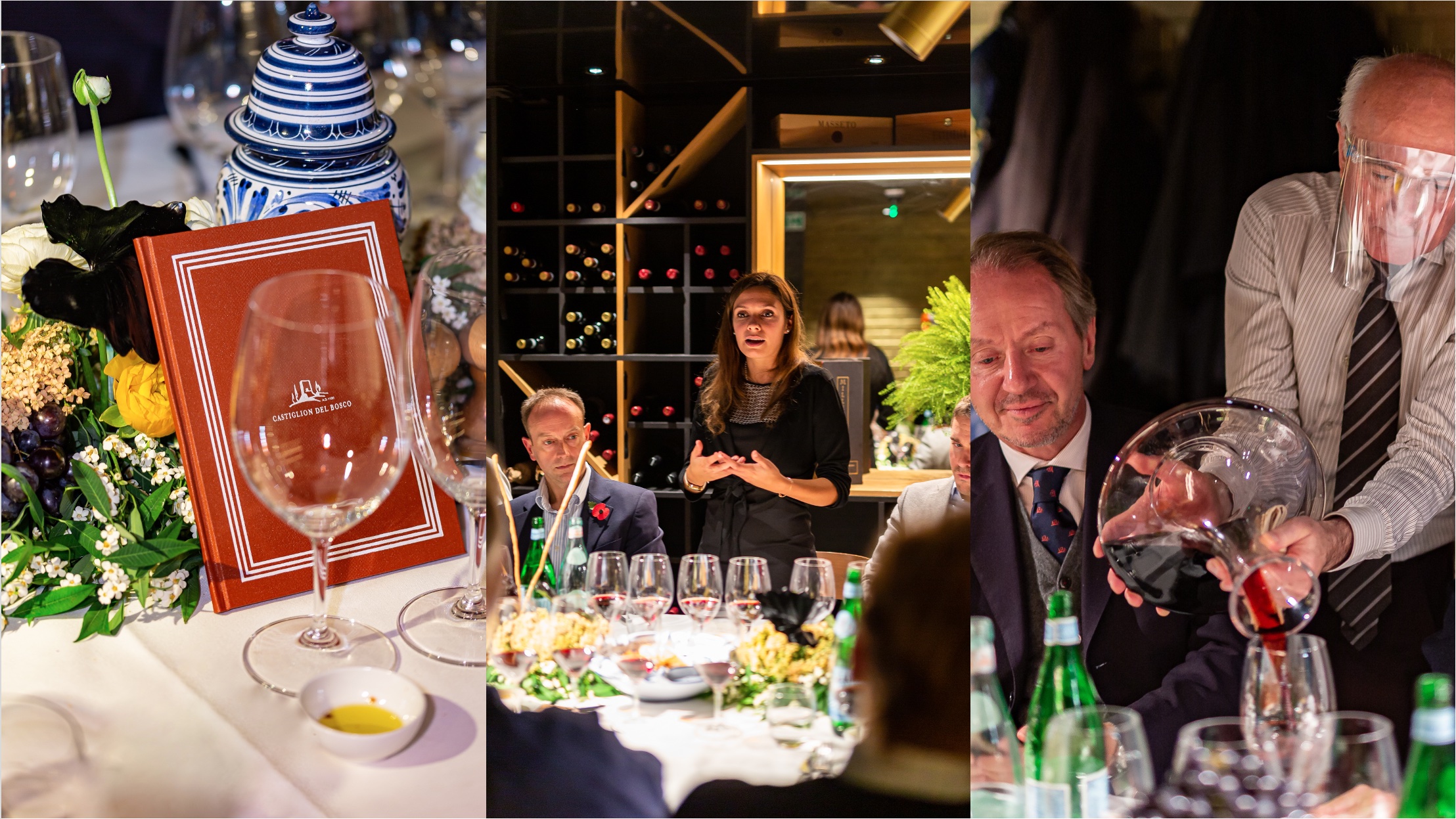 Bespoke menu (left), Castiglion del Bosco’s Marketing Manager, Gemma Grieco talking guests through the line-up (middle), Enoteca Turi owner, Giovanni Turi pouring the wines (right)
Bespoke menu (left), Castiglion del Bosco’s Marketing Manager, Gemma Grieco talking guests through the line-up (middle), Enoteca Turi owner, Giovanni Turi pouring the wines (right)
The 2016 Riserva – some of the best from Brunello?
With big shoes to fill following the release of the highly-praised 2015, the 2016 marks the second great year in a row for Brunello di Montalcino, though very different from its predecessor. Whilst the 2015 growing season was hot and dry, 2016 was slightly cooler, with greater diurnal range during the ripening season. These climatic differences result in the 2015s being more generous in both texture and body, while the successive vintage is pure and elegant, with significant ageing potential.
Having been at the property since its acquisition by Massimo Ferragamo in 2004, Castiglion del Bosco’s winemaker Cecilia Leoneschi describes the 2016 as the estate’s “best ever” Brunello. The mild summer encouraged a long, slow ripening, while good conditions at harvest allowed the estate to “harvest each vineyard at the perfect moment” – resulting in “rich wines with outstanding elegance”.
Cecilia hails the 2016 vintage of Castiglion del Bosco’s Riserva Millecento (so-named due to the property’s original construction in 1100) as having “arrived at our intention”. She refers to creating a wine that reflects the magnificence of the estate’s past, while “representing what we want our future to be”. Finally, she adds that the 2016 relays the estate’s key message with absolute purity, as the growing season allowed her to finetune her senses, and “listen to the land” completely.
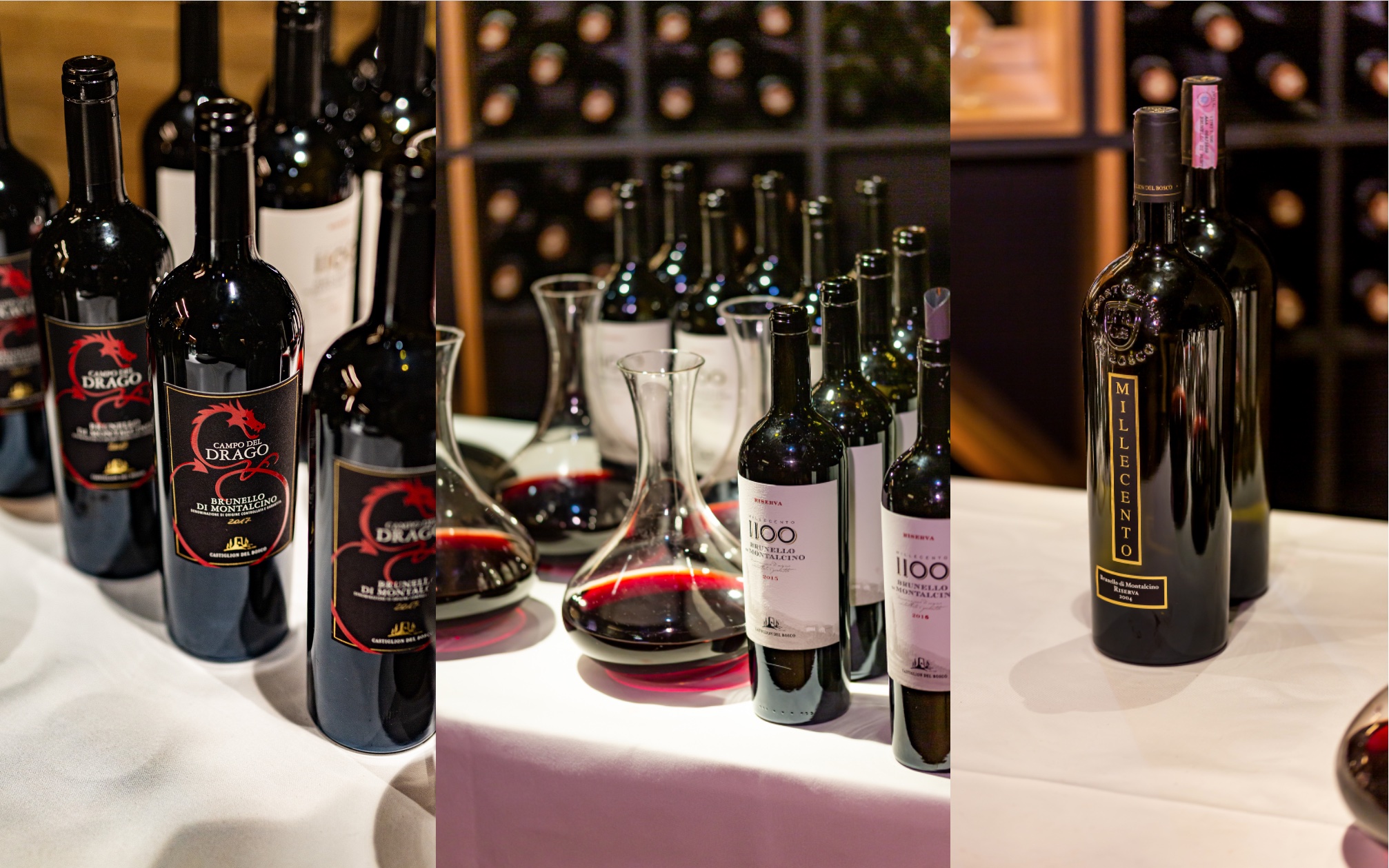 Campo del Drago 2017 (left), Riserva Millecento 2015 and 2016 (middle), and Riserva Millecento 2004 (right)
Campo del Drago 2017 (left), Riserva Millecento 2015 and 2016 (middle), and Riserva Millecento 2004 (right)
Bringing to life the best of Brunello
The Castiglion del Bosco team came to London on Thursday 14th November to tell the tales of the Riserva Millecento 2016 to an audience of 25 industry members and fine wine collectors. Bringing Tuscany to Chelsea, and the estate’s historic past to the present, all guests left with a short storybook, detailing key moments at Castiglion del Bosco that shape the estate’s future, and of course, its wines.
The chosen pouring order of wines, paired with a traditional Tuscan fare from Enoteca Turi’s Head Chef, Massimo Tagliaferri was also symbolic of the changing hands of time, and those traditions maintained – vintages 2004, 2010, 2015, and 2016 we served side-by-side, and tasters were invited to try from 2004 upwards, and back down again.
2004 was the first Riserva made under the current team, while the 2010 was the first to be released under the “Millecento” name. A direct comparison of the 2015 and 2016 – the latest Riserva released, and that which is yet to come – illustrates what Cecilia describes as “two different approaches to quality” in consecutive years.
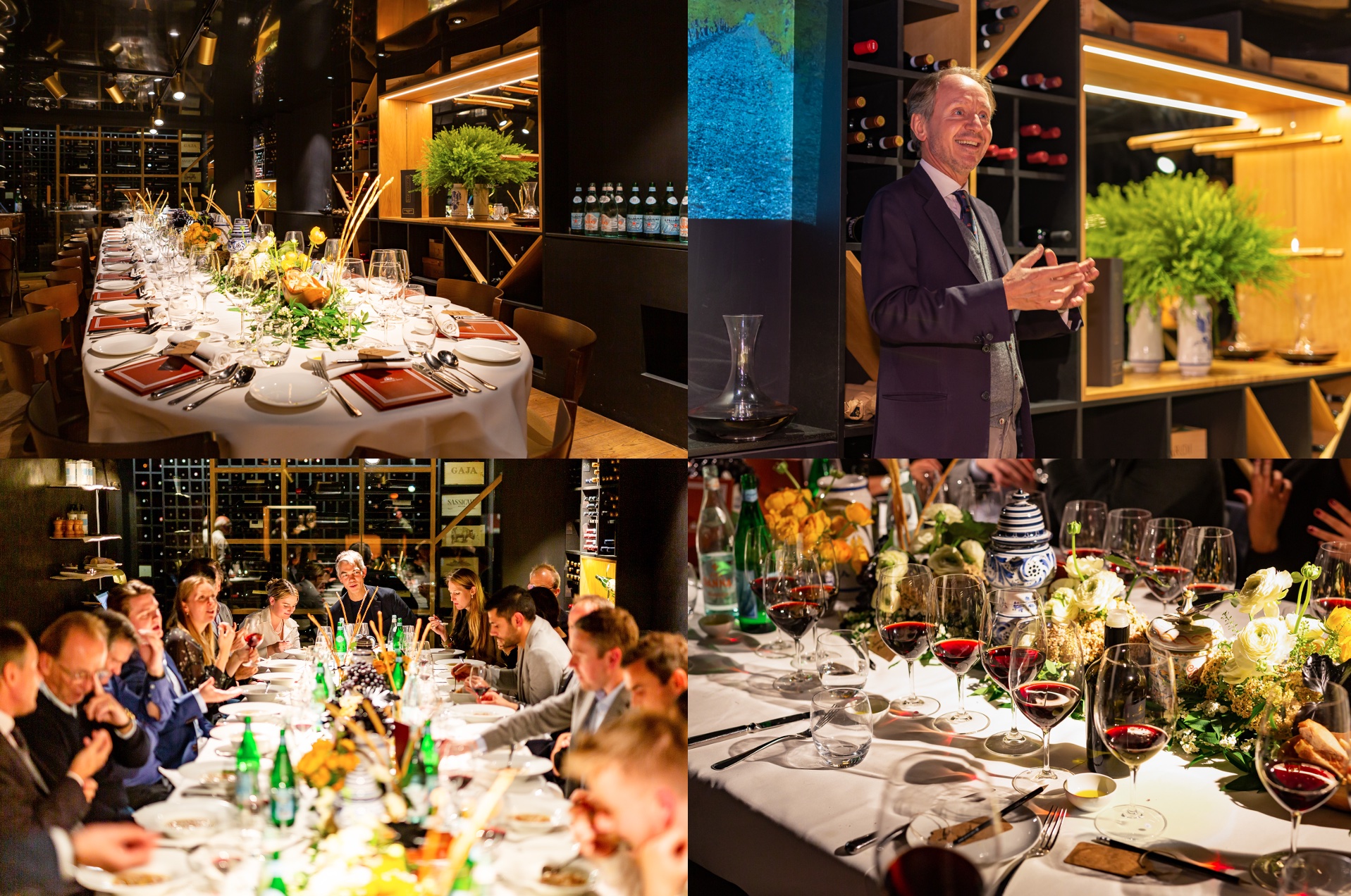 Table designed by Isabelle Buckland (top left), Castiglion del Bosco’s CEO, Simone Pallesi greeting the guests (top right), guests enjoying their aperitivo, Zuppa di Cipolle (bottom left), and the complete Riserva line-up (bottom right)
Table designed by Isabelle Buckland (top left), Castiglion del Bosco’s CEO, Simone Pallesi greeting the guests (top right), guests enjoying their aperitivo, Zuppa di Cipolle (bottom left), and the complete Riserva line-up (bottom right)
Wines tasted: Brunello 2017, Campo del Drago Brunello 2017, Riserva Millecento 2016, Riserva Millecento 2015, Riserva Millecento 2010, and Riserva Millecento 2004 (from Massimo Ferragamo’s private cellar), and a Vin Santo 2014 to finish.
For more information on our organisation of tastings and events, please contact the WLPR team here.
Margaux’s Wine of the Vintage?
Our latest article takes a closer look at one of the final entries in the Place de Bordeaux’s September 2021 Campaign, as we examine Palmer’s re-release from one of Bordeaux’s most challenging recent vintages.
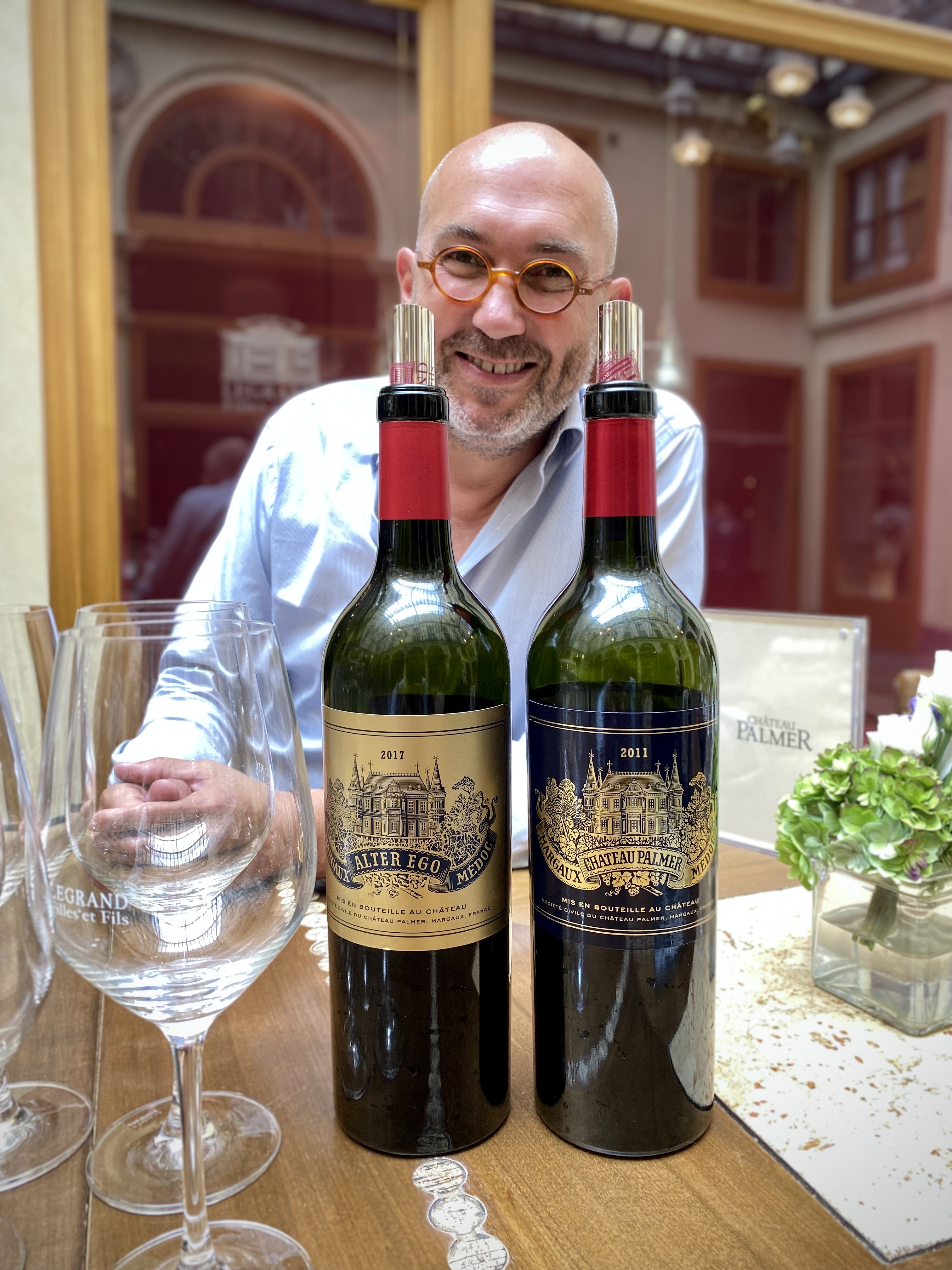 Palmer’s Director, Thomas Duroux tasting Palmer 2011 and Alter Ego 2017 with Wine Lister CEO, Ella Lister
Palmer’s Director, Thomas Duroux tasting Palmer 2011 and Alter Ego 2017 with Wine Lister CEO, Ella Lister
What is the story behind Palmer’s 2011 vintage?
Palmer’s precious secrets
A decade on from production, Thursday 23rd September saw the re-release of Palmer 2011 with a recommended UK onward selling price of £228 per bottle (in-bond). This release represents the second instalment of their ‘10 years on’ series, which presents decade-old ex-château stocks to the market via the Place de Bordeaux. While still releasing Palmer’s latest vintages en primeur, the estate’s Director, Thomas Duroux tells Wine Lister CEO, Ella Lister that withholding stock for ex-château release for 10 years plays tribute to Émile Peynaud’s philosophy that “A great wine needed at latest 10 years of age before it was ready to drink”.
The story of a peculiar vintage
Building momentum amongst merchants and collectors for the release of a notoriously challenging vintage is no mean feat. Duroux’s deft storytelling played on the strengths of Palmer’s historically low yields, reminiscing the events of this curious vintage to encourage interest in the re-release. With a mere 20 hl, the 2011 produced less than half the yield of a normal year, and the even-greater scarcity of re-release availability (approximately 1,000 cases) was surely designed to entice further demand. Several Bordeaux properties suffered at the hands of a significant hailstorm on 4th June 2011, with some falling victim to damage in the crucial berry set period. Although Palmer felt the effects of the growing season, it nonetheless still produced a well-scored wine, matching the average WL score of first growths Margaux, Lafite, and Mouton (93).
Crunch time
Duroux links the quality of their 2011 to the somewhat merciful timing of the hailstorm. Having passed through flowering, the berries were small and able to withstand the storm’s impact, with the damage sustained mostly by the vine’s young shoots. Since the vines compensated by rerouting their energy to grow new shoots, they devoted less energy to fruit development, therefore the harvest yielded a smaller collection of concentrated berries. Such details serve as a good reminder, that the story of a vintage can only paint a partial (and general) picture – digging into the detail of each estate can uncover so much more potential.
Key fine wine releases from Bordeaux and Beyond
As another week of releases draws to a close, we reflect on highlights from the past fortnight, including the latest vintages of signature New and Old World wines, offered through the Place de Bordeaux’s impressive network.
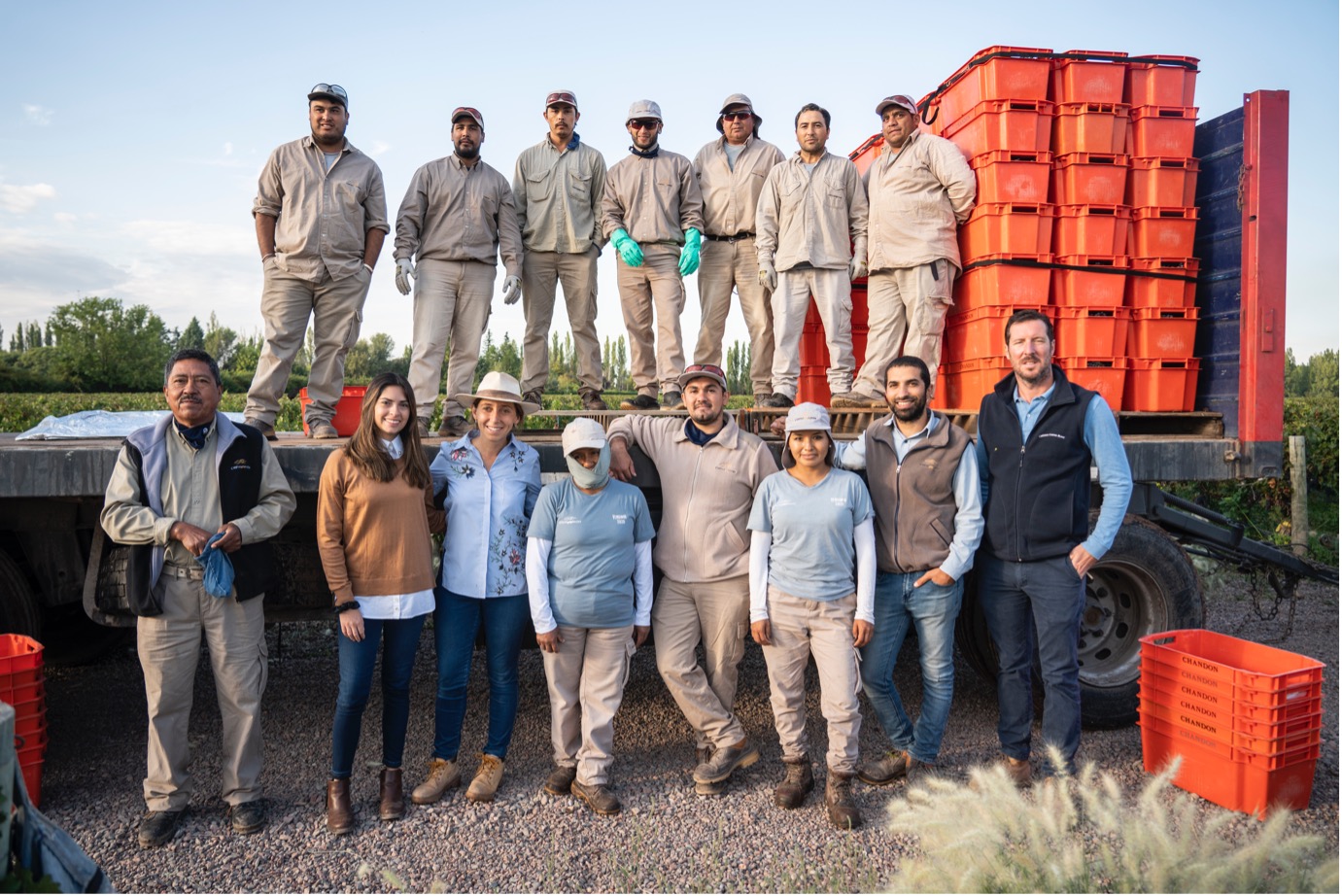 Cheval des Andes’ Technical Director, Gerald Gabillet (bottom right), with the winemaking team
Cheval des Andes’ Technical Director, Gerald Gabillet (bottom right), with the winemaking team
Which wines offer the best investments from the Place de Bordeaux’s September campaign?
As well as a further flurry of releases from the Americas and Tuscany, the past two weeks have also witnessed exciting French entries from the likes of the Rhône Valley, and a re-release of Latour 2005.
California dreaming
One of the top 20 fine wine brands in the world (according to its Wine Lister Pro Brand score), Opus One released its 40th vintage, 2018 last Monday (6th September), at £230 per bottle (in-bond). Wine Lister partner critic, Antonio Galloni (Vinous) gives the latest release a score of 95, describing it as “incredibly elegant and polished, right out of the bottle”.
Napa Valley neighbour, Beaulieu Vineyard’s Georges de Latour Private Reserve 2018 was released on Tuesday (14th September) at £115 per bottle (in-bond). Describing the wine as “sensational”, with notes of “inky red fruit, chocolate, leather, and liquorice”, Galloni gives the latest vintage 98 points – its joint-highest score ever awarded by the critic body. Joseph Phelps’ Insignia 2018 entered the market in quick succession on Tuesday at £163 per bottle (in-bond). Sampled by Wine Lister COO, Chloe Ashton at a recent tasting at 67 Pall Mall (alongside the 2010 and 1998), she found the evolution in complexity, tension, and precision was clear to see.
Monday (13th September) witnessed a triptych of 2018s from Sonoma County’s Vérité, with La Muse, Le Désir, and La Joie released onto the market at £300 per bottle each (in-bond). With the wines representing distinct expressions of the estate through the bespoke blending of different varietals and plots, the Merlot-based La Muse receives a perfect 100-point score from Lisa Perrotti-Brown for Wine Advocate, who calls it “Electrifying!”. Comprising a majority blend of Cabernet Franc, Le Désir gains 97+ and 97 points from Perrotti-Brown and Suckling, respectively. Whilst being Wine Lister CEO, Ella Lister’s favourite amongst the three, the Cabernet Sauvignon-dominant La Joie 2018 secures its highest average critics scores since 2013, inclusive of 98 points from Perrotti-Brown and 99 points from Suckling.
South American sensations
Leading last week’s South American entries, Baron Philippe de Rothschild’s Chilean winery Almaviva released its 2019 vintage on Wednesday (8th September) at £108 per bottle (in-bond). The Wine Lister team found it to show good complexity for its young age, with dense black fruit, exotic spices, and a touch of hay smoke.
Across to Argentina, Cheval des Andes 2018 was released on Thursday (9th September) at £59 per bottle (in-bond). The latest vintage aligns with the estate’s upward quality trajectory in recent years, having been awarded a score of 98 from James Suckling, who describes it as “very long and structured, yet controlled and in balance”.
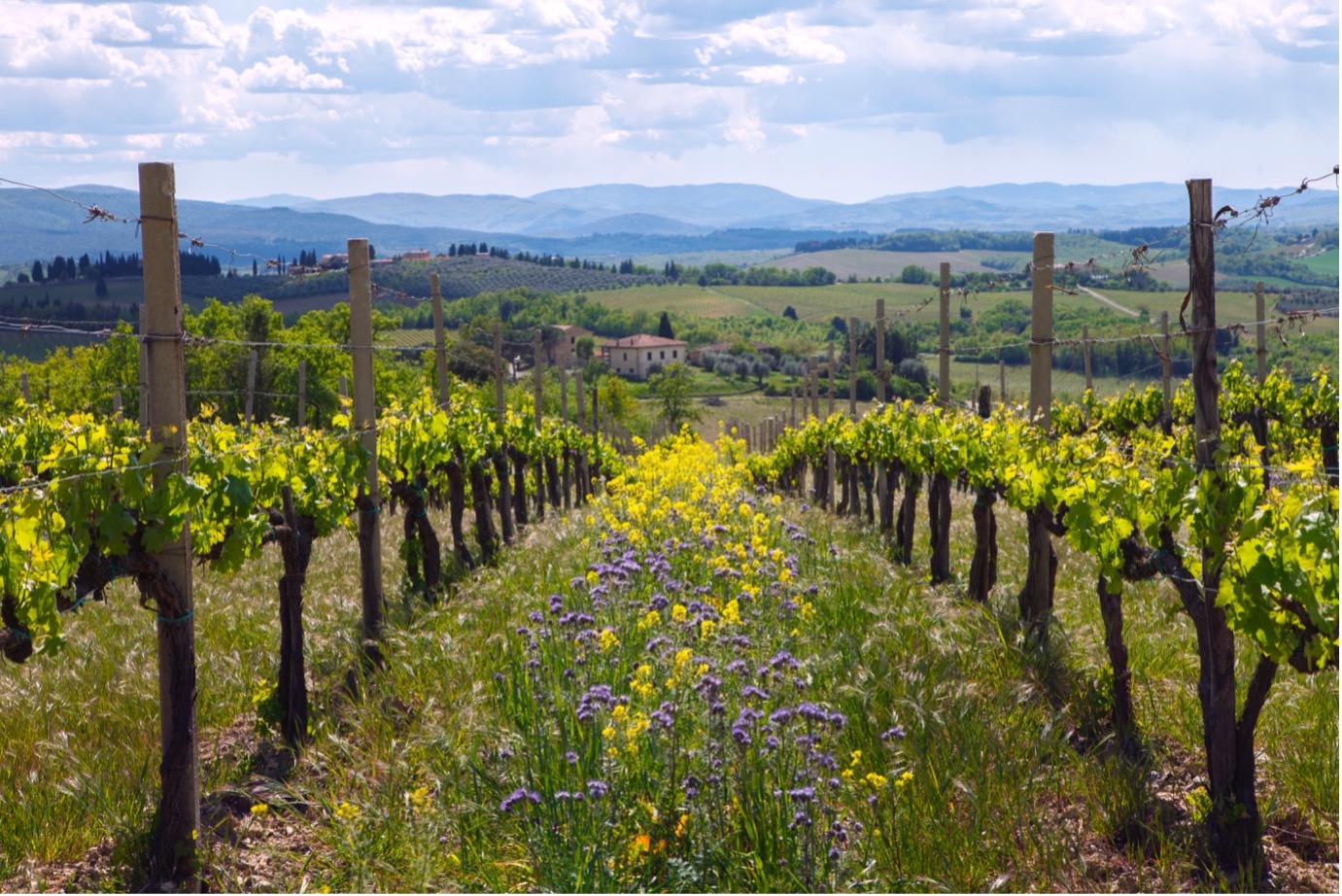 Wildflowers growing in-between Siepi’s Merlot and Sangiovese vines
Wildflowers growing in-between Siepi’s Merlot and Sangiovese vines
A Tuscan triumph
There are now only limited remaining stocks of Masseto 2018, which was released on Tuesday (7th September), starting from £495 per bottle (in-bond). The estate saw one of the rainiest springs in its history, and consequentially faced high levels of disease pressure. Nonetheless, the team at Masseto handled challenges that arose deftly, reflected in Wine Lister’s praise of its dense, layered, and lithe texture.
Now with similarly limited availability at around £208 per bottle (in-bond), Solaia 2018 was released on Thursday (9th September). Galloni awards it a strong score of 98, noting that he “can’t remember ever tasting a young Solaia with this much sheer appeal and balance”. Demand for the 2018 may well be encouraged by the estate’s positive price performance track record, which has seen some of its top-scoring vintages appreciate significantly post-release.
The first of the Tuscan trio to be released last week was Petrolo’s Galatrona 2019, which entered the market on Monday (13th September) at £72 per bottle (in-bond). Gaining a near-perfect score of 99 points from Suckling, he describes it as “muscular, yet agile” – “a unique definition of merlot in Tuscany”. Following in close succession, Castello di Fonterutoli released Siepi 2019 at £68 per bottle (in-bond). The Mazzei family planted its first Merlot grapes in 1980, with Siepi’s varietal blend now comprising equal proportions of Merlot and Sangiovese. The 2019 gains 98 points from Suckling – the joint-highest score awarded by the critic, who praises its “super-structure”, and “finesse with power”. To end Monday’s Tuscan trilogy, Tenuta Sette Ponti’s Orma 2019 was released at £56 per bottle (in-bond). Though Orma is yet to be widely scored by critics, Suckling awards it 97 points, calling it “perhaps the best Orma ever”.
Closing this week’s Italian offerings, Caiarossa 2018 entered the market on Wednesday (15th September) at £35 per bottle (in-bond). Walter Speller for Wine Lister partner critic, JancisRobinson.com, awards it 17+ points, considering it “classy stuff”, “which should become even more compelling with further bottle ageing”.
Back on French soil
Speculated to be the final commercial release of the vintage, Latour released a parcel of its 2005 vintage last Tuesday (7th September), which has since been offered by merchants for around £750 per bottle (in-bond). The 2005 was awarded 100 points by Galloni, who calls it “deep and sensual to the core”, and notes that it is “utterly captivating”. The iconic reputation of both the vintage and the estate is reiterated in this perfect score, which should stimulate interest from serious fine wine collectors.
Racing over to the Rhône, Beaucastel Hommage à Jacques Perrin 2019 was released last Friday (10th September) at around £227 per bottle (in-bond). A cask sample score from Alistair Cooper for JancisRobinson.com signifies quality, awarding its highest score from the critic body since 2007 with 19 points, calling it “One to watch!”.
Click here to sign up to Wine Lister’s newsletter to stay up-to-date with the latest from the Place de Bordeaux’s September campaign.
New World icons join top Tuscan wines for the first week of releases
A trading system used to distribute Bordeaux wines for almost 800 years, the Place de Bordeaux has, in more recent years, provided an international stage for many wines originating beyond its own borders. The first non-Bordeaux bottle to join La Place in 1998 was Almaviva, followed by Opus One in 2004, Masseto in 2008, and Solaia in 2009. Over the past decade, a further flurry of eminent estates from around the world have joined the distribution network, and together they form a campaign of new vintage releases every September.
 Seña and Chadwick owner, Eduardo Chadwick, and daughter, Magui
Seña and Chadwick owner, Eduardo Chadwick, and daughter, Magui
Which fine wines were released through the Place de Bordeaux this week?
South American superstars
Clos Apalta 2018 kicked off this year’s campaign on Tuesday 31st August, at £71.50 per bottle (in-bond). At this year’s CVBG London tasting at Berry Bros. & Rudd, Wine Lister enjoyed the elegance of the latest release, which boasted red fruits, pepper, and a hint of smokiness on the nose, and a fresh acidity and energy on the palate. Another vintage that adheres to the estate’s impressive quality consistency over the past five years, demand for the 2018 is further encouraged by Clos Apalta’s status as one of Chile’s leading wine brands.
Across the Andes, Catena Zapata released its 2018 vintage on Wednesday 1st September, with Nicolàs Catena Zapata entering the market at £53 per bottle (in-bond). Having gained 96 points from Joaquín Hidalgo for Wine Lister partner critic Vinous.com, the latest vintage achieves its highest ever-score from the critic outfit. He calls it “breathtaking”, with “layers of aroma, beginning with black currant and moving on to intense, precise notes of lavender and mint along with hints of black tea, sage and cigar box”.
Released yesterday (Thursday 2nd September) at £80 per bottle (in-bond), Seña 2019 was the product of a “long, stable ripening season”, according to owner, Eduardo Chadwick. Tasting with Wine Lister on Zoom, he explains that while “January did begin warmer than usual, summer in March was cooler than normal”, retaining freshness. Indeed, our team found the 2019 to be beautifully balanced, perfumed with muddled berries, sweet spice, and promising complexity of cherries and rustic earth, with satin tannins, on the palate. Supplemented by its high quality, the special-edition 25th-anniversary bottling should stimulate interest in Seña’s latest offering.
Describing Viñedo Chadwick 2019 as “one of the best recent vintages”, Eduardo tells us that, as ever, the character of the wine is shaped by the estate’s altitude. He explains that the great diurnal range throughout the warm growing season allowed freshness, encouraging what Wine Lister found to be both remarkable lift and flavour intensity, with aromas of iris, fresh herbs, and blackberry. Released onto the market at c.£230 per bottle, the 2019 was awarded 99 points by James Suckling, who echoes the sentiment that the wine is “refined, yet powerful”.
South African sweetness
On Wednesday 1st September, Klein Constantia released its Vin de Constance 2018 at £41 per bottle (in-bond). Wine Lister tasted the latest release on Zoom alongside Winemaker, Matt Day, and found notes of citrus and stone fruits complemented with notes of ginger on the nose, complete with a generous and balanced palate with a lightness and freshness that defies the stereotypes of “sweet wine”. Matt told us he believes the vintage represents an embodiment of his “fine-tuned” craft, which also coincided with “a perfect [growing] season”, encouraging the continuation of its positive quality trajectory this year. Indeed, the latest release (as yet not scored by any Wine Lister partner critics) gains 98 points from James Suckling in his most recent tasting.
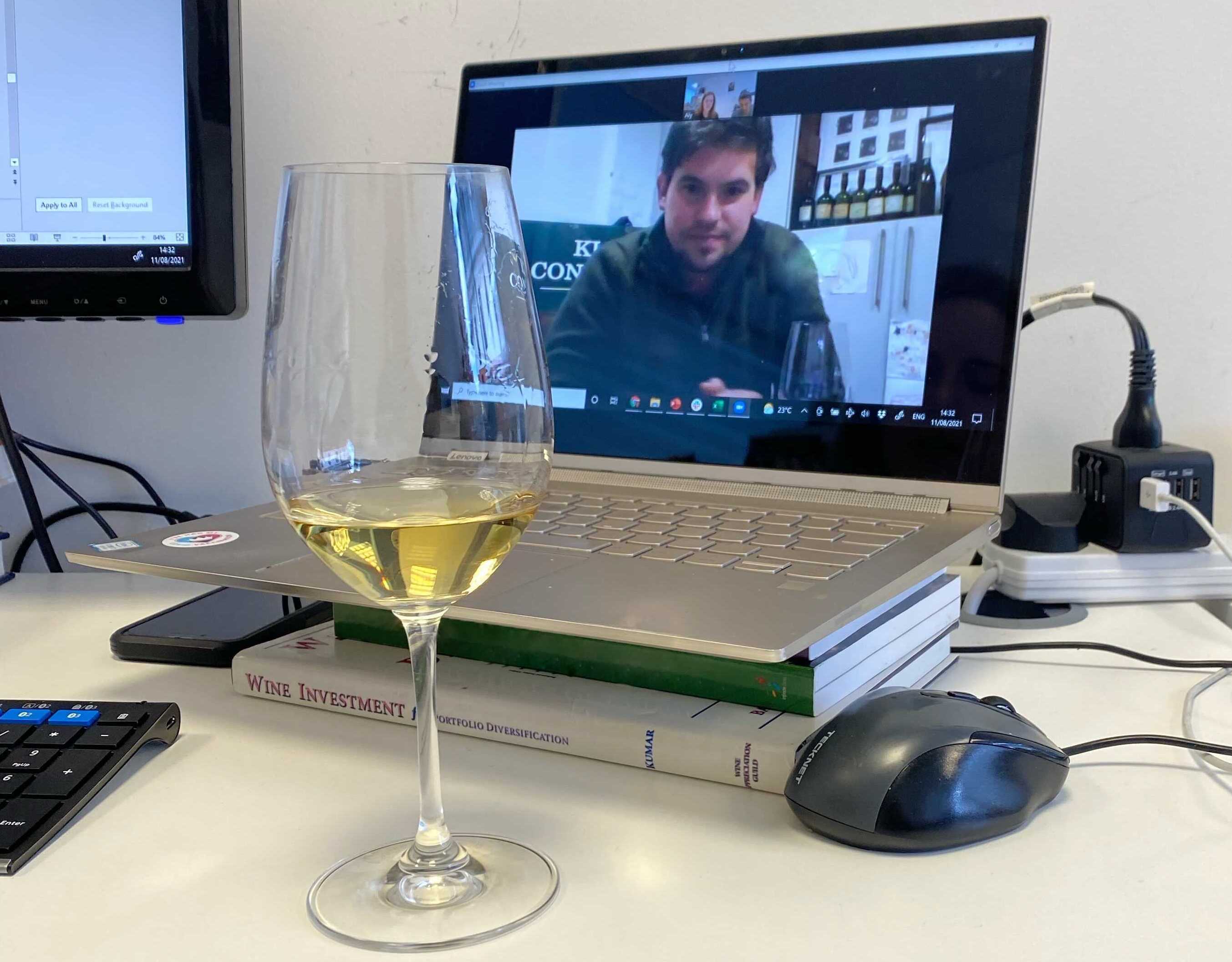 Tasting Vin de Constance 2018 alongside Klein Constantia Winemaker, Matt Day
Tasting Vin de Constance 2018 alongside Klein Constantia Winemaker, Matt Day
Top Tuscan offerings
Bibi Graetz’s Testamatta and Colore 2019 entered the market yesterday (Thursday 2nd September), at £73 and £180 per bottle (in-bond), respectively. Marking its 20th anniversary vintage, both wines feature special-edition bottles designed by artist turned vigneron, Bibi Graetz, with colour and text applied directly onto the glass. Wine Lister was particularly impressed with Colore 2019, which boasted a perfumed nose of violets, frangipane, and crushed berries, following through to a vibrant and juicy palate with silky tannins.
Wines likely to be released through the Place de Bordeaux next week include: Opus One 2018, Overture NV, Masseto 2018, Massetino 2019, Latour 2005, Almaviva 2019, Epu 2019, Cheval des Andes 2018, Solaia 2018, and Beaucastel Hommage à Jacques Perrin 2019.









 Bespoke menu (left), Castiglion del Bosco’s Marketing Manager, Gemma Grieco talking guests through the line-up (middle), Enoteca Turi owner, Giovanni Turi pouring the wines (right)
Bespoke menu (left), Castiglion del Bosco’s Marketing Manager, Gemma Grieco talking guests through the line-up (middle), Enoteca Turi owner, Giovanni Turi pouring the wines (right) Campo del Drago 2017 (left), Riserva Millecento 2015 and 2016 (middle), and Riserva Millecento 2004 (right)
Campo del Drago 2017 (left), Riserva Millecento 2015 and 2016 (middle), and Riserva Millecento 2004 (right) Table designed by Isabelle Buckland (top left), Castiglion del Bosco’s CEO, Simone Pallesi greeting the guests (top right), guests enjoying their aperitivo, Zuppa di Cipolle (bottom left), and the complete Riserva line-up (bottom right)
Table designed by Isabelle Buckland (top left), Castiglion del Bosco’s CEO, Simone Pallesi greeting the guests (top right), guests enjoying their aperitivo, Zuppa di Cipolle (bottom left), and the complete Riserva line-up (bottom right) Palmer’s Director, Thomas Duroux tasting
Palmer’s Director, Thomas Duroux tasting 


